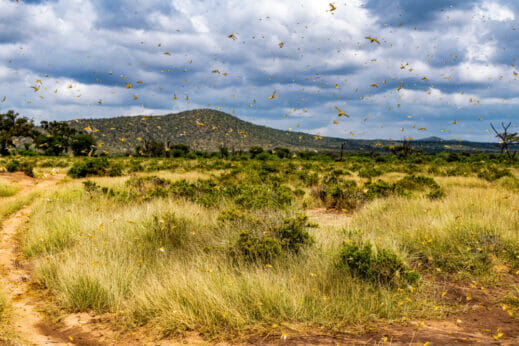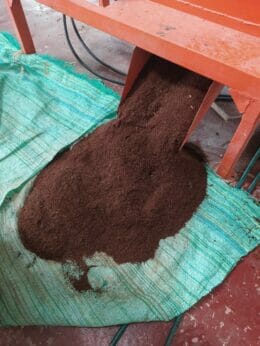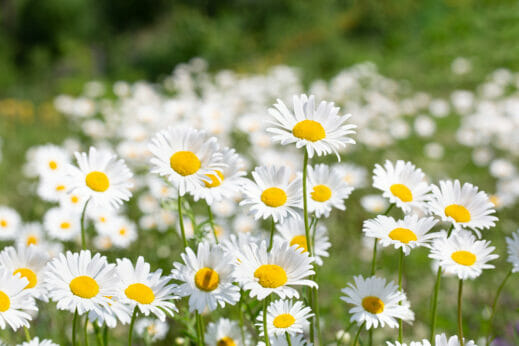Turning a Locust Invasion into a Fertilizer Boon
Following a multi-year locust plague, organizers in Kenya are making the most of the pestilential swarm.
Turning a Locust Invasion into a Fertilizer Boon
Following a multi-year locust plague, organizers in Kenya are making the most of the pestilential swarm.

A swarm of desert locusts can be made up of 150 million locusts per square kilometer.by Shutterstock.
They say when life throws you lemons, you make lemonade. But what happens when life throws swarms of desert locusts your way? You could make fertilizer from those locusts, as a team of innovators in Kenya demonstrated after a devastating invasion.
Running from 2018 to early 2022, the massive locust outbreak that hit parts of Eastern Africa and the Middle East destroyed hundreds of thousands of acres of crops and posed a severe food security threat to about 3 million people.
But research on desert locusts has revealed an interesting fact: The voracious insects have a rich composition of nitrogen and other macro-nutrients that enrich soils and help to grow crops.
Regenerative agriculture company The Bug Picture (TBP), which is based in Kenya and focused on insect-based sustainability projects, used this information to produce something positive from the pestilential invasion.
“Nobody was prepared for the infestation as we had not had desert locusts for 70 years—there were only stories from those times—so the devastation to people was immense,” Laura Stanford, founder and director of TBP, told us via email. “I have seen the benefits of insects for people and the environment, so I was compelled to take action and see these insects as an opportunity to create a silver lining to the devastation of the infestation. Desert locusts are just clouds of protein and nitrogen flying across the sky at the end of the day, so how could we harvest them? And that is what we went out to discover.”

Through community mobilization and partnerships, TBP came up with an innovative program to harvest and convert desert locusts into compost manure using a rudimentary process of milling and composting. In addition to the desert locust biofertilizer, the company and partners also devised eight animal feed formulations using desert locusts as a base.
In the model adopted by TBP, community members receive payment for every scoop of desert locusts they collect, earning Ksh 50 ($0.46) per kg, making it a win-win for both the fertilizer manufacturer and affected communities.
“Our team and partners chased the swarms across grasslands, forests and savannah [with elephants and the like] on the back of motorbikes by day and worked with communities to harvest them by night,” said Stanford. “In the six weeks that we were on the ground before we were shut down by COVID-19 travel restrictions, close on 4.3 tons of desert locusts were harvested by the communities that we worked with. For us and our partners, we see this as a huge success.”

Preparation of the fertilizer takes six weeks and involves composting milled desert locusts in a controlled environment, mixed with dried reeds, corn stalks, hay or straw. The mixture is laid in a rainproof area, covered in a layer of forest soil, and turned every three or four days to facilitate composting. Enriching the mix is a combination of molasses dissolved in unchlorinated water. Some water is added to maintain the consistent moisture of clumping but not dripping, as the composting process will stop if the pile dries. The end product is a well-rotted mix that is sweet smelling, integrated and generally dark and uniform in appearance.
Scilla Allen, from the Rumuruti region of Kenya, was among the first to use the fertilizer. She says the results were impressive after applying the locust fertilizer on her plot of land, where she grows pyrethrum, a type of daisy.
“The pyrethrum did very well,” says Allen. “We got much improved quality last year, and though we got affected by the ongoing drought like everybody else, the pyrethrum has survived. I think a lot of it is due to the quality of the compost. Besides pyrethrum, we also used the compost on vegetables and they showed good results. I am very pleased with the results.”

Increasing soil fertility is just one of the aims of the TBP’s project. The hope, according to Stanford, is that boosting nitrogen levels could actually discourage future locust swarms. “This approach would ultimately deter future swarms as locusts are attracted to areas with low nitrogen levels in their soil; that is, overgrazed areas,” she said.
Research has shown that excessive livestock grazing promotes locust outbreaks by lowering plant nitrogen content due to soil degradation. A 2015 study, which cites findings from locust outbreaks in Inner Mongolia, showed that locusts showed preference for and thrived best on low-protein plants found in degraded or heavily grazed pastures, and similar findings have been recorded in outbreaks elsewhere around the world.
Even without being incorporated into compost, desert locust invasions have been shown to boost nitrogen levels in the soil. Over the course of their lives, they divert nitrogen from plants to the soil, and when they die, they are decomposed by microorganisms, releasing nutrients such as nitrogen and carbon, which then become available for plant uptake.
However, the composting process resulted in faster release of the nutrients in the locusts for plants to access, according to tests conducted by TBP. “Also notable is that all locusts used in this composting trial were sprayed, yet only two samples came back with pesticide residue of which neither were Deltamethrin, which is the chemical that they were sprayed with,” observed the researchers. “This creates the hypothesis that composting can result in faster decomposition of the chemicals, therefore reducing their long-term impacts on the environment.”
Although the threat from the recent swarms of pillaging bugs has passed in the Horn Region, TBP is hoping that the success of its project demonstrates the viability of using alternative methods for responding to the locusts and that this approach can be scaled for affected communities in the future.
For Stanford, it was the rapid, all-hands-on-deck response from collaborators and community members that gave this natural disaster its silver lining. “This was all possible through close collaboration with donors and partners who believe that it is possible to innovate towards nature-based solutions in the time of crises, which definitely seemed like a crazy idea until we were doing it.”
Follow us
This work is licensed under a Creative Commons Attribution-NoDerivatives 4.0 International License.
Want to republish a Modern Farmer story?
We are happy for Modern Farmer stories to be shared, and encourage you to republish our articles for your audience. When doing so, we ask that you follow these guidelines:
Please credit us and our writers
For the author byline, please use “Author Name, Modern Farmer.” At the top of our stories, if on the web, please include this text and link: “This story was originally published by Modern Farmer.”
Please make sure to include a link back to either our home page or the article URL.
At the bottom of the story, please include the following text:
“Modern Farmer is a nonprofit initiative dedicated to raising awareness and catalyzing action at the intersection of food, agriculture, and society. Read more at <link>Modern Farmer</link>.”
Use our widget
We’d like to be able to track our stories, so we ask that if you republish our content, you do so using our widget (located on the left hand side of the article). The HTML code has a built-in tracker that tells us the data and domain where the story was published, as well as view counts.
Check the image requirements
It’s your responsibility to confirm you're licensed to republish images in our articles. Some images, such as those from commercial providers, don't allow their images to be republished without permission or payment. Copyright terms are generally listed in the image caption and attribution. You are welcome to omit our images or substitute with your own. Charts and interactive graphics follow the same rules.
Don’t change too much. Or, ask us first.
Articles must be republished in their entirety. It’s okay to change references to time (“today” to “yesterday”) or location (“Iowa City, IA” to “here”). But please keep everything else the same.
If you feel strongly that a more material edit needs to be made, get in touch with us at [email protected]. We’re happy to discuss it with the original author, but we must have prior approval for changes before publication.
Special cases
Extracts. You may run the first few lines or paragraphs of the article and then say: “Read the full article at Modern Farmer” with a link back to the original article.
Quotes. You may quote authors provided you include a link back to the article URL.
Translations. These require writer approval. To inquire about translation of a Modern Farmer article, contact us at [email protected]
Signed consent / copyright release forms. These are not required, provided you are following these guidelines.
Print. Articles can be republished in print under these same rules, with the exception that you do not need to include the links.
Tag us
When sharing the story on social media, please tag us using the following: - Twitter (@ModFarm) - Facebook (@ModernFarmerMedia) - Instagram (@modfarm)
Use our content respectfully
Modern Farmer is a nonprofit and as such we share our content for free and in good faith in order to reach new audiences. Respectfully,
No selling ads against our stories. It’s okay to put our stories on pages with ads.
Don’t republish our material wholesale, or automatically; you need to select stories to be republished individually.
You have no rights to sell, license, syndicate, or otherwise represent yourself as the authorized owner of our material to any third parties. This means that you cannot actively publish or submit our work for syndication to third party platforms or apps like Apple News or Google News. We understand that publishers cannot fully control when certain third parties automatically summarize or crawl content from publishers’ own sites.
Keep in touch
We want to hear from you if you love Modern Farmer content, have a collaboration idea, or anything else to share. As a nonprofit outlet, we work in service of our community and are always open to comments, feedback, and ideas. Contact us at [email protected].by Joseph Maina, Modern Farmer
March 15, 2023
Modern Farmer Weekly
Solutions Hub
Innovations, ideas and inspiration. Actionable solutions for a resilient food system.
ExploreExplore other topics
Share With Us
We want to hear from Modern Farmer readers who have thoughtful commentary, actionable solutions, or helpful ideas to share.
SubmitNecessary cookies are absolutely essential for the website to function properly. This category only includes cookies that ensures basic functionalities and security features of the website. These cookies do not store any personal information.
Any cookies that may not be particularly necessary for the website to function and are used specifically to collect user personal data via analytics, ads, other embedded contents are termed as non-necessary cookies.
What a genius idea!
the article doesn’t explain how they were harvested. by hand, nets, rakes?
Besides being a fertilizer, the locusts could also serve as a delicacy edibles. They were source of food for Middle Eastern people for thousands of years; legend has it that locusts were favorite food of St. John the Baptist.